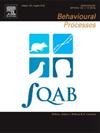Aerial urination suggests undescribed sensory modality and social function in river dolphins
IF 1.3
4区 生物学
Q4 BEHAVIORAL SCIENCES
引用次数: 0
Abstract
Scent marking through urine spraying is known to aid mate selection, territory marking and chemical communication in terrestrial, but not in aquatic mammals. We quantify an unusual aerial urination behaviour in botos (Inia geoffrensis) and discuss its potential functions. Between 2014 and 2018, we conducted land-based behavioural surveys on wild botos in central Brazil, recording the sequence, duration and social context of aerial urination. Aerial urination starts with a boto slowly positioning itself upside down, exposing its penis above water, and ejecting a stream of urine into the air. When a ‘receiver’ male is present, it either approaches the urine stream with its rostrum (sometimes pursuing it) or stays where the stream contacts the water. We recorded 36 aerial urination events during 218.9 observation hours, with 67 % occurring in the presence of receivers. The events were short (11.6 ± 9.6 SD s), highly variable (range 1–41 s) and involved only males—urinators and receivers. We hypothesize that the bristles on botos’ rostrums can serve a chemical sensory role (haptosense) in detecting urine streams and that aerial urination, often occurring in the presence of other males, serves social or communicative functions beyond the physiological need for waste elimination.
空中排尿暗示了河豚未被描述的感觉方式和社会功能。
在陆生哺乳动物中,通过尿液喷洒进行气味标记有助于择偶、领土标记和化学交流,但在水生哺乳动物中则不然。我们量化了一种不寻常的空中排尿行为,并讨论了它的潜在功能。2014年至2018年期间,我们对巴西中部的野生动物进行了陆地行为调查,记录了空中排尿的顺序、持续时间和社会背景。空中排尿开始时,鱼慢慢地把自己倒立起来,把阴茎露出水面,然后把一股尿液喷射到空气中。当一个“接收者”在场时,它要么用它的喙靠近尿液流(有时追着它),要么呆在尿液流接触水的地方。我们在218.9个观察小时内记录了36例空中排尿事件,其中67%发生在接收器在场的情况下。事件较短(11.6±9.6秒),变化很大(范围1- 41秒),仅涉及男性小便者和接受者。我们假设,牛喙上的鬃毛可以起到一种化学感觉作用(触觉),用于检测尿液流,而空中排尿,通常发生在其他雄性在场的情况下,除了消除废物的生理需要外,还具有社交或交流功能。
本文章由计算机程序翻译,如有差异,请以英文原文为准。
求助全文
约1分钟内获得全文
求助全文
来源期刊

Behavioural Processes
生物-动物学
CiteScore
2.70
自引率
7.70%
发文量
144
审稿时长
4-8 weeks
期刊介绍:
Behavioural Processes is dedicated to the publication of high-quality original research on animal behaviour from any theoretical perspective. It welcomes contributions that consider animal behaviour from behavioural analytic, cognitive, ethological, ecological and evolutionary points of view. This list is not intended to be exhaustive, and papers that integrate theory and methodology across disciplines are particularly welcome.
 求助内容:
求助内容: 应助结果提醒方式:
应助结果提醒方式:


